LinSM¶
文档信息 Document Information¶
版本历史 Version History¶
日期(Date) |
作者(Author) |
版本(Version) |
状态(Status) |
说明(Description) |
|---|---|---|---|---|
2024/11/15 |
caihong.liu |
V0.1 |
发布(Release) |
首次发布(First release) |
2025/04/04 |
caihong.liu |
V1.0 |
发布(Release) |
正式发布(Official release) |
参考文档 References¶
编号(Number) |
分类(Classification) |
标题(Title) |
版本(Version) |
|---|---|---|---|
1 |
Autosar |
AUTOSAR_CP_SWS_LINStateManager.pdf |
R23-11 |
2 |
Autosar |
AUTOSAR_SWS_LINInterface.pdf |
R23-11 |
3 |
Autosar |
AUTOSAR_CP_SWS_COMManager.pdf |
R23-11 |
术语与简写 Terms and Abbreviations¶
术语 Terms¶
术语(Terms) |
解释(Explanation) |
|---|---|
MASTER Node |
LIN总线拓扑结构中的唯一主机节点,同时支持主机任务和从机任务(The unique master node in the LIN bus topology, which supports both master tasks and slave tasks) |
SLAVE Node |
LIN总线拓扑结构中的从机节点,从机节点只支持从机任务(The slave node in the LIN bus topology, which only supports slave tasks) |
Schedule Table |
规定总线上帧的传输次序以及各帧在总线上的传输时间的配置(A configuration that specifies the transmission order of frames on the bus and the transmission time of each frame on the bus) |
简写 Abbreviations¶
简写(Abbreviation) |
全称(Full name) |
解释(Explanation) |
|---|---|---|
LIN |
Local Interconnect Network |
局部互联网络 |
LinIf |
LIN Interface |
局部互联网络接口 |
LinSM |
LIN State Manager |
局部互联网络状态管理 |
BswM |
BSW Mode Manager |
基础软件模式管理 |
ComM |
Communication Manager |
通信管理 |
简介 Introduction¶
本文档是AUTOSAR R23-11的LIN State Manager模块参考手册。手册描述AUTOSAR规范的LinSM模块相关功能、API、配置,旨在指导使用LinSM模块的用户能够清晰地了解如何去使用LinSM模块。
This document is the reference manual for the LIN State Manager module of AUTOSAR R23-11. The manual describes the functions, APIs, and configurations related to the LinSM module specified in the AUTOSAR standard, aiming to guide users who use the LinSM module to clearly understand how to use the LinSM module.
如下图 AUTOSAR BSW software architecture - LIN stack scope. 所示,LinSM模块的下层是Lin Interface,上层是ComM,BswM等。其主要职责是控制Lin总线的控制流。主要功能包括以下三点:
As shown in Figure AUTOSAR BSW software architecture - LIN stack scope. below, the lower layer of the LinSM module is the Lin Interface, and the upper layers include ComM, BswM, etc. Its main responsibility is to control the control flow of the LIN bus. The main functions include the following three points:
1.根据上层的请求切换到相应的调度表
1.Switch to the corresponding schedule table according to the request from the upper layer
2.根据上层的请求对LIN通道处理Go-to-sleep或wake-up流程
2.Process the Go-to-sleep or wake-up process for the LIN channel according to the request from the upper layer
3.当LIN通道状态切换到新状态时通知上层模块
3.Notify the upper-layer modules when the LIN channel state switches to a new state

AUTOSAR BSW software architecture - LIN stack scope.¶
功能描述 Functional Description¶
特性 Features¶
LIN网络的状态管理功能 State Management Function of LIN Network¶
LinSM模块的功能主要体现在对Lin通道的网络管理功能,LinSM根据上层对Lin通道的通信状态请求,对该通道进行相应的休眠或唤醒操作。同时,LinSM内部为每个通道维护独立的状态机记录该通道的通信模式,根据当前的通信模式体现休眠唤醒操作成功与否。
The function of the LinSM module is mainly reflected in the network management of Lin channels. According to the upper layer’s request for the communication state of the Lin channel, LinSM performs corresponding sleep or wakeup operations on the channel. At the same time, LinSM internally maintains an independent state machine for each channel to record the communication mode of the channel, and reflects the success or failure of the sleep and wakeup operations according to the current communication mode.
按照状态机流转顺序主要功能为:
According to the sequence of state machine transitions, the main functions are:
1.LinSM模块上电后处于非初始化状态,初始化后记录各通道状态为 LINSM_NO_COM 状态,即无通信
1.The LinSM module is in an uninitialized state after power-on. After initialization, the state of each channel is recorded as LINSM_NO_COM state, that is, no communication.
2.当上层请求 COMM_FULL_COMMUNICATION 时,相应Lin通道启动Wake up流程,唤醒成功则记录该通道为 LINSM_FULL_COM 状态,即启动通信
2.When the upper layer requests COMM_FULL_COMMUNICATION, the corresponding Lin channel starts the Wake up process. If the wakeup is successful, the channel is recorded as LINSM_FULL_COM state, that is, communication is started.
3.当上层请求 COMM_NO_COMMUNICATION 时,相应Lin通道启动Goto Sleep流程,休眠成功则记录该通道为 LINSM_NO_COM 状态
3.When the upper layer requests COMM_NO_COMMUNICATION, the corresponding Lin channel starts the Goto Sleep process. If the sleep is successful, the channel is recorded as LINSM_NO_COM state.
除上描述外,LinSM不受理其他类型的通信状态请求
Except as described above, LinSM does not accept other types of communication state requests.
Wake up¶
当LinSM模块初始化后,且Lin通道处于LINSM_NO_COM,上层调用LinSM_RequestComMode()向某通道请求COMM_FULL_COMMUNICATION,LinSM立即将该请求通过LinIf_Wakeup()函数转发到LinIf模块,LinIf_Wakeup()的返回值都将直接返回给上层调用者。
After the LinSM module is initialized and the Lin channel is in LINSM_NO_COM, the upper layer calls LinSM_RequestComMode() to request COMM_FULL_COMMUNICATION for a certain channel. LinSM immediately forwards the request to the LinIf module through the LinIf_Wakeup() function. The return value of LinIf_Wakeup() will be directly returned to the upper-layer caller.
只有当LinIf_Wakeup()返回E_OK则对该通道启动 Wake up 进程:
The Wake up process for the channel is started only when LinIf_Wakeup() returns E_OK:
加载 唤醒超时计时器 ,计时器数值根据配置决定
Load the wakeup timeout timer, the timer value is determined according to the configuration.
加载 唤醒重试计数器 ,计数器数值根据配置决定
Load the wakeup retry counter, the counter value is determined according to the configuration.
进程结束:
End of process:
1.LinSM_WakeupConfirmation()函数被回调
1.The LinSM_WakeupConfirmation() function is called back.
1.1入参success为TRUE时,表示该通道唤醒成功,记录该通道通信状态为LINSM_FULL_COM,且子状态为 LINSM_RUN_COMMUNICATION。
1.1When the input parameter success is TRUE, it indicates that the channel wakeup is successful. The communication state of the channel is recorded as LINSM_FULL_COM, and the sub-state is LINSM_RUN_COMMUNICATION.
1.2入参success为FALSE时,表示该通道唤醒失败,维持当前状态为LINSM_NO_COM
1.2When the input parameter success is FALSE, it indicates that the channel wakeup failed, and the current state remains LINSM_NO_COM.
1.3无论入参结果,LinSM都要回调ComM_BusSM_ModeIndication()和BswM_LinSM_CurrentState()传递该通道当状态
1.3Regardless of the input parameter result, LinSM shall call back ComM_BusSM_ModeIndication() and BswM_LinSM_CurrentState() to transmit the current state of the channel.
2.`唤醒超时计时器` 超时,则 唤醒重试计数器 减一,重置 唤醒超时计时器 且再调用LinIf_Wakeup(),当 唤醒重试计数器 减至0时:
2.When the wakeup timeout timer expires, the wakeup retry counter is decremented by 1, the wakeup timeout timer is reset, and LinIf_Wakeup() is called again. When the wakeup retry counter is decremented to 0:
2.1调用Det_ReportRuntimeError上报错误码 LINSM_E_CONFIRMATION_TIMEOUT
2.2Call Det_ReportRuntimeError to report the error code LINSM_E_CONFIRMATION_TIMEOUT.
2.3当通道类型为MASTER时:可继续为该通道调用LinIf_Wakeup()
2.3When the channel type is MASTER: LinIf_Wakeup() can continue to be called for the channel.
2.4当通道类型为SLAVE时:加载silence-after-wakeup计时器,进入静默状态,该计时器超时后重启Wake up进程
2.4When the channel type is SLAVE: Load the silence-after-wakeup timer, enter the silent state, and restart the Wake up process after the timer expires.
Goto Sleep¶
当LinSM模块初始化后,且Lin通道处于LINSM_FULL_COM,上层调用LinSM_RequestComMode()向某通道请求COMM_NO_COMMUNICATION。
After the LinSM module is initialized and the LIN channel is in LINSM_FULL_COM, the upper layer calls LinSM_RequestComMode() to request COMM_NO_COMMUNICATION for a certain channel.
1.对于MASTER类型的Lin通道:LinSM立即将该请求通过LinIf_GotoSleep()函数转发到LinIf模块,LinIf_GotoSleep()的返回值都将直接返回给上层调用者,当LinIf_GotoSleep()返回E_OK则对该通道启动 Goto Sleep 进程。
1.For LIN channels of MASTER type: LinSM immediately forwards the request to the LinIf module through the LinIf_GotoSleep() function. The return value of LinIf_GotoSleep() will be directly returned to the upper-layer caller. When LinIf_GotoSleep() returns E_OK, the Goto Sleep process for the channel is started.
2.对于SLAVE类型的Lin通道:LinSM为该通道记录该状态请求,直接返回E_OK。当LinIf检测到总线睡眠时,LinIf对该通道被调用LinSM_GotoSleepIndication(),此时调用LinIf_GotoSleep()且返回E_OK则对该通道启动 Goto Sleep 进程。
2.For LIN channels of SLAVE type: LinSM records the state request for the channel and directly returns E_OK. When LinIf detects that the bus is sleeping, LinIf calls LinSM_GotoSleepIndication() for the channel. At this time, calling LinIf_GotoSleep() and returning E_OK starts the Goto Sleep process for the channel.
Goto Sleep进程启动时,记录该通道状态为LINSM_FULL_COM下的子状态 LINSM_GOTO_SLEEP
When the Goto Sleep process starts, the state of the channel is recorded as the sub-state LINSM_GOTO_SLEEP under LINSM_FULL_COM.
进程结束:
End of process:
1.上层对已经启动Goto Sleep进程的通道的状态请求不变时,LinSM维持该通道处于LINSM_GOTO_SLEEP状态,直到LinSM_GotoSleepConfirmation()被回调,记录该通道状态为LINSM_NO_COM且回调ComM_BusSM_ModeIndication()和BswM_LinSM_CurrentState()传递该通道当状态
1.When the state request of the upper layer for the channel that has started the Goto Sleep process remains unchanged, LinSM maintains the channel in the LINSM_GOTO_SLEEP state until LinSM_GotoSleepConfirmation() is called back. Then, the state of the channel is recorded as LINSM_NO_COM, and ComM_BusSM_ModeIndication() and BswM_LinSM_CurrentState() are called back to transmit the current state of the channel.
调度表切换功能 Schedule Table Switching Function¶
调度表切换功能仅支持MASTER类型Lin通道,且主动请求切换时该通道必须已处于唤醒状态,即 LINSM_FULL_COM 状态
The schedule table switching function only supports MASTER-type Lin channels, and when actively requesting switching, the channel must be in the wakeup state, i.e., LINSM_FULL_COM state.
请求切换调度表:
Request to switch the schedule table:
1.BswM通过调用LinSM_ScheduleRequest()发送调度表切换请求,LinSM通过调用LinIf_ScheduleRequest()将该请求传递到LinIf。LinIf_ScheduleRequest()返回E_NOT_OK时,LinSM将当前调度表作为入参调用BswM_LinSM_CurrentSchedule()
1.BswM sends a schedule table switching request by calling LinSM_ScheduleRequest(). LinSM transmits the request to LinIf by calling LinIf_ScheduleRequest(). When LinIf_ScheduleRequest() returns E_NOT_OK, LinSM calls BswM_LinSM_CurrentSchedule() with the current schedule table as the input parameter.
调度表切换指示:
Schedule table switching indication:
1.LinIf切换调度表时,将回调LinSM_ScheduleRequestConfirmation(),LinSM记录该通道当前的调度表,并将当前调度表作为入参调用BswM_LinSM_CurrentSchedule()
1.When LinIf switches the schedule table, it will call back LinSM_ScheduleRequestConfirmation(). LinSM records the current schedule table of the channel and calls BswM_LinSM_CurrentSchedule() with the current schedule table as the input parameter.
Attention
LinIf具有自动切换调度表的机制,即请求切换调度表与调度表切换指示并非一一对应,LinSM_ScheduleRequestConfirmation()被回调时不一定是因为调用过LinSM_ScheduleRequest()
LinIf has a mechanism for automatically switching schedule tables, that is, the request to switch the schedule table does not correspond one-to-one with the schedule table switching indication. LinSM_ScheduleRequestConfirmation() may be called back not necessarily because LinSM_ScheduleRequest() has been called.
偏差 Deviation¶
1.移除ComM_BusSM_BusSleepMode()回调
1.Remove the ComM_BusSM_BusSleepMode() callback.
1.1因为Autosar在LinSM文档描述:当SLAVE通道被调用LinSM_GotoSleepIndication()且该通道请求的通信类型为COMM_NO_COMMUNICATION,则调用LinIf_GotoSleep()且返回E_OK时回调ComM_BusSM_BusSleepMode()。而在ComM文档中描述:Lin_Slave通道配置项ComMNmVariant应为SLAVE_ACTIVE,对于此种配置的通道只有当ComM_BusSM_BusSleepMode()被回调时对该通道请求COMM_NO_COMMUNICATION。两者描述冲突
1.1Because AUTOSAR describes in the LinSM document: When the SLAVE channel is called LinSM_GotoSleepIndication() and the communication type requested by the channel is COMM_NO_COMMUNICATION, ComM_BusSM_BusSleepMode() is called back when LinIf_GotoSleep() is called and returns E_OK. However, the ComM document describes: The configuration item ComMNmVariant for the Lin_Slave channel should be SLAVE_ACTIVE. For channels with such configuration, COMM_NO_COMMUNICATION is requested for the channel only when ComM_BusSM_BusSleepMode() is called back. The two descriptions conflict.
1.2所以LinSM中移除ComM_BusSM_BusSleepMode()回调,ComM将Lin_Slave通道配置项ComMNmVariant修改为LIGHT
1.2Therefore, the ComM_BusSM_BusSleepMode() callback is removed from LinSM, and ComM modifies the configuration item ComMNmVariant of the Lin_Slave channel to LIGHT.
扩展 Extension¶
None
集成 Integration¶
文件列表 File List¶
静态文件 Static Files¶
文件(File) |
描述(Description) |
|---|---|
LinSM.c |
模块源文件(Module source file) |
LinSM.h |
模块头文件(Module header file) |
LinSM_Internal.h |
模块内部头文件(Module internal header file) |
动态文件 Dynamic Files¶
文件(File) |
描述(Description) |
|---|---|
LinSM_Cfg.c |
配置源文件(Configuration source file) |
LinSM_Cfg.h |
配置头文件(Configuration header file) |
错误处理 Error Handling¶
开发错误 Development Errors¶
Error code |
Value[hex] |
Description |
|---|---|---|
LINSM_E_UNINIT |
0x00 |
Referenced network does not exist (identification is out of range) |
LINSM_E_NONEXISTENT_NETWORK |
0x20 |
API called without initialization of LinSM |
LINSM_E_PARAMETER |
0x30 |
Referenced network does not exist (identification is out of range) |
LINSM_E_PARAM_POINTER |
0x40 |
API service called with invalid pointer |
LINSM_E_INIT_FAILED |
0x50 |
Init function failed |
LINSM_E_PARTITION |
0x60 |
API service called in wrong partition |
LINSM_E_PARTITION_UNINIT |
0x70 |
API called without initialization of channel partition |
运行时错误 Runtime Errors¶
Error code |
Value[hex] |
API called without initialization of LinSM |
|---|---|---|
LINSM_E_CONFIRMATION_TIMEOUT |
0x00 |
Timeout of the callbacks from LinIf |
类型定义 Type Definitions¶
Type Name |
Type |
Description |
|---|---|---|
LinSM_ModeType |
uint8 |
|
LinSM_ConfigType |
struct |
The root struct configuration parameters of LinSM. |
Type Name |
Type |
Description |
|---|---|---|
LinSM_RunTimeType |
struct |
Runtime variables. |
LinSM_ScheduleType |
struct |
Record the schedule table configuration of a channel. |
LinSM_ScheduleVariant |
struct |
Record all schedule table configurations for a variant. |
LinSM_ChannelType |
struct |
Channel-related configuration parameter structure. |
提供的服务 Services¶
LinSM_Init¶
void LinSM_Init(const LinSM_ConfigType *ConfigPtr)
This function initializes the LinSM.
- Sync/Async
Synchronous
- Reentrancy
Reentrant(Reentrant for different partitions, Non Reentrant for the same partiton.)
Parameters
Dir |
Name |
Description |
|---|---|---|
[in] |
ConfigPtr |
Pointer to the LinSM post-build configuration data. |
- Return type
void
LinSM_ScheduleRequest¶
Std_ReturnType LinSM_ScheduleRequest(NetworkHandleType network, LinIf_SchHandleType schedule)
The upper layer requests a schedule table to be changed on one LIN network.
- Sync/Async
Asynchronous
- Reentrancy
Reentrant
Parameters
Dir |
Name |
Description |
|---|---|---|
[in] |
network |
Identification of the LIN channel. |
[in] |
schedule |
Index of the scheduled table. |
- Return type
Std_ReturnType
Return values
Name |
Description |
|---|---|
E_OK |
Schedule table request has been accepted. |
E_NOT_OK |
Schedule table switch request has not been accepted due to one of the following reasons:
|
LinSM_GetVersionInfo¶
void LinSM_GetVersionInfo(Std_VersionInfoType *versioninfo)
Function to get the version information of LinSM.
- Sync/Async
Synchronous
- Reentrancy
Reentrant
Parameters
Dir |
Name |
Description |
|---|---|---|
[in] |
versioninfo |
Pointer to where to store the version information of this module. |
- Return type
void
LinSM_GetCurrentComMode¶
Std_ReturnType LinSM_GetCurrentComMode(NetworkHandleType network, ComM_ModeType *mode)
Function to query the current communication mode.
- Sync/Async
Synchronous
- Reentrancy
Reentrant
Parameters
Dir |
Name |
Description |
|---|---|---|
[in] |
network |
Identification of the LIN channel. |
[in] |
mode |
Returns the active mode, see ComM_ModeType for descriptions of the modes. |
- Return type
Std_ReturnType
Return values
Name |
Description |
|---|---|
E_OK |
OK |
E_NOT_OK |
Not possible to perform the request, e.g. not initialized. |
LinSM_RequestComMode¶
Std_ReturnType LinSM_RequestComMode(NetworkHandleType network, ComM_ModeType mode)
Requesting of a communication mode. The mode switch will not be made instant. The LinSM will notify the caller when mode transition is made.
- Sync/Async
Asynchronous
- Reentrancy
Reentrant
Parameters
Dir |
Name |
Description |
|---|---|---|
[in] |
network |
Identification of the LIN channel |
[in] |
mode |
Request mode |
- Return type
Std_ReturnType
Return values
Name |
Description |
|---|---|
E_OK |
Request accepted |
E_NOT_OK |
Not possible to perform the request, e.g. not initialized. |
LinSM_ScheduleRequestConfirmation¶
void LinSM_ScheduleRequestConfirmation(NetworkHandleType network, LinIf_SchHandleType schedule)
The LinIf module will call this callback when the new requested schedule table is active.
- Sync/Async
Synchronous
- Reentrancy
Reentrant
Parameters
Dir |
Name |
Description |
|---|---|---|
[in] |
network |
Identification of the LIN channel. |
[in] |
schedule |
Index of the scheduled table. |
- Return type
void
LinSM_GotoSleepIndication¶
void LinSM_GotoSleepIndication(NetworkHandleType network)
The LinIf will call this callback when the go to sleep command is received on the network or a bus idle timeout occurs.
- Sync/Async
Synchronous
- Reentrancy
Reentrant (Reentrant for different Channels)
Parameters
Dir |
Name |
Description |
|---|---|---|
[in] |
network |
Identification of the LIN channel |
- Return type
void
LinSM_GotoSleepConfirmation¶
void LinSM_GotoSleepConfirmation(NetworkHandleType network, boolean success)
The LinIf will call this callback when the go to sleep command is sent successfully or not sent successfully on the network.
- Sync/Async
Synchronous
- Reentrancy
Reentrant
Parameters
Dir |
Name |
Description |
|---|---|---|
[in] |
network |
Identification of the LIN channel |
[in] |
success |
True if goto sleep was successfully sent, false otherwise |
- Return type
void
LinSM_WakeupConfirmation¶
void LinSM_WakeupConfirmation(NetworkHandleType network, boolean success)
The LinIf will call this callback when the wake up signal command is sent not successfully/successfully on the network.
- Sync/Async
Synchronous
- Reentrancy
Reentrant
Parameters
Dir |
Name |
Description |
|---|---|---|
[in] |
network |
Identification of the LIN channel |
[in] |
success |
True if wakeup was successfully sent, false otherwise |
- Return type
void
LinSM_MainFunction_<LinSMChannel.ShortName>¶
void LinSM_MainFunction_<LinSMChannel.ShortName>(void)
Periodic function that runs the timers of different request timeouts.
- Sync/Async
Synchronous
- Reentrancy
Reentrant (Reentrant for different Channels)
- Return type
void
配置 Configuration¶
唤醒超时计时器 Wakeup Timeout Timer¶
Lin通道在启动Wake up进程时需要加载的超时计时器以及重试计数器根据配置决定超时计时器各通道间独立配置,配置项位于LinSMChannel/LinSMConfirmationTimeout。该配置参数为浮点型,范围大小为[0 ..INF],单位为秒。计时器在周期性调度函数LinSM_MainFunction()中递减,所以建议实际值为主函数运行周期的整数倍。当该值配置为0时意为永不会触发超时。
The timeout timer and retry counter that the Lin channel needs to load when starting the Wake up process are determined by configuration.The timeout timer is configured independently for each channel, and the configuration item is located at LinSMChannel/LinSMConfirmationTimeout. This configuration parameter is of floating-point type, with a range of [0 .. INF] in seconds. The timer decrements in the periodic scheduling function LinSM_MainFunction(), so it is recommended that the actual value be an integer multiple of the main function running period. When this value is configured as 0, it means that the timeout will never be triggered.
1.LinSMConfirmationTimeout配置截图:(单位:s,参数值要大于唤醒命令在Lin通道上的传播时间)
1.Screenshot of LinSMConfirmationTimeout configuration: (Unit: s, the parameter value must be greater than the propagation time of the wakeup command on the Lin channel)
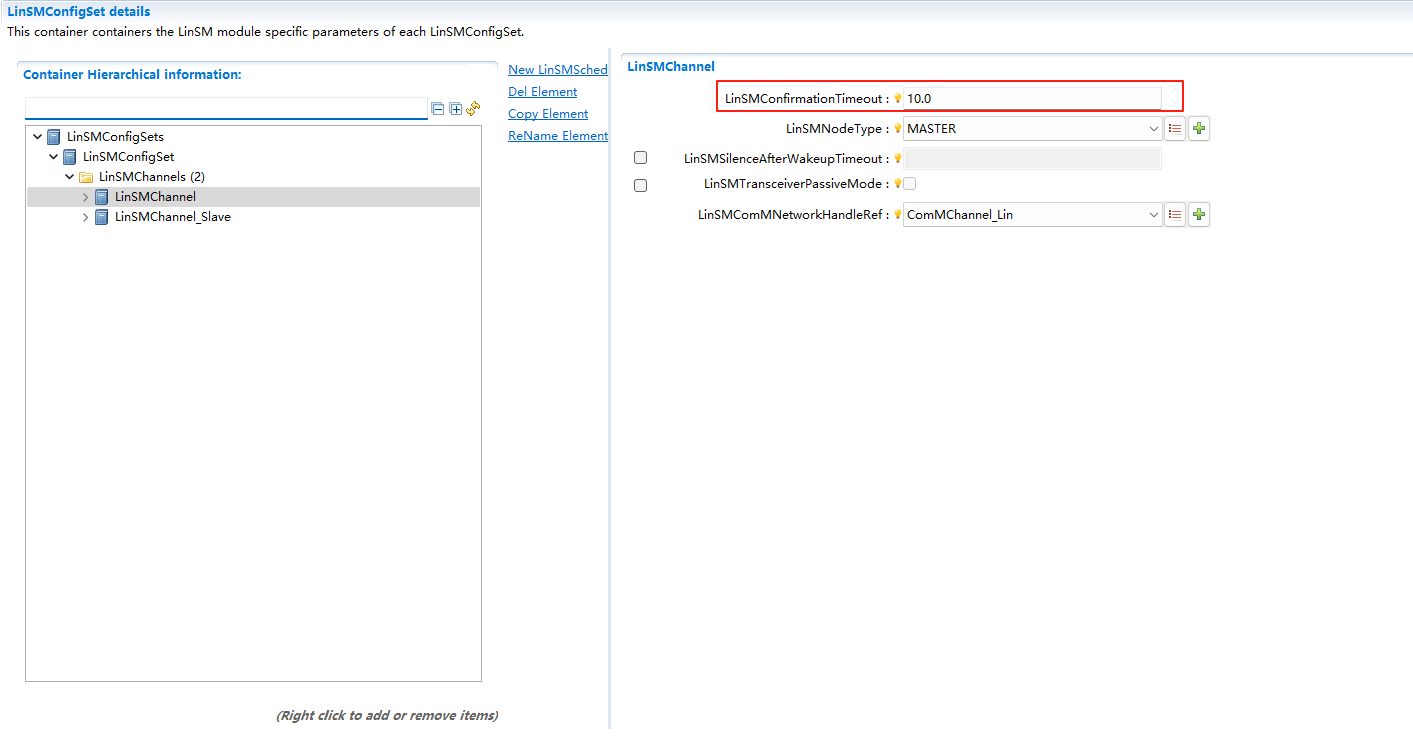
fig_LinSMConfirmationTimeout¶
LinSMMainProcessingPeriod配置截图:(单位:s)
Screenshot of LinSMMainProcessingPeriod configuration: (Unit: s)
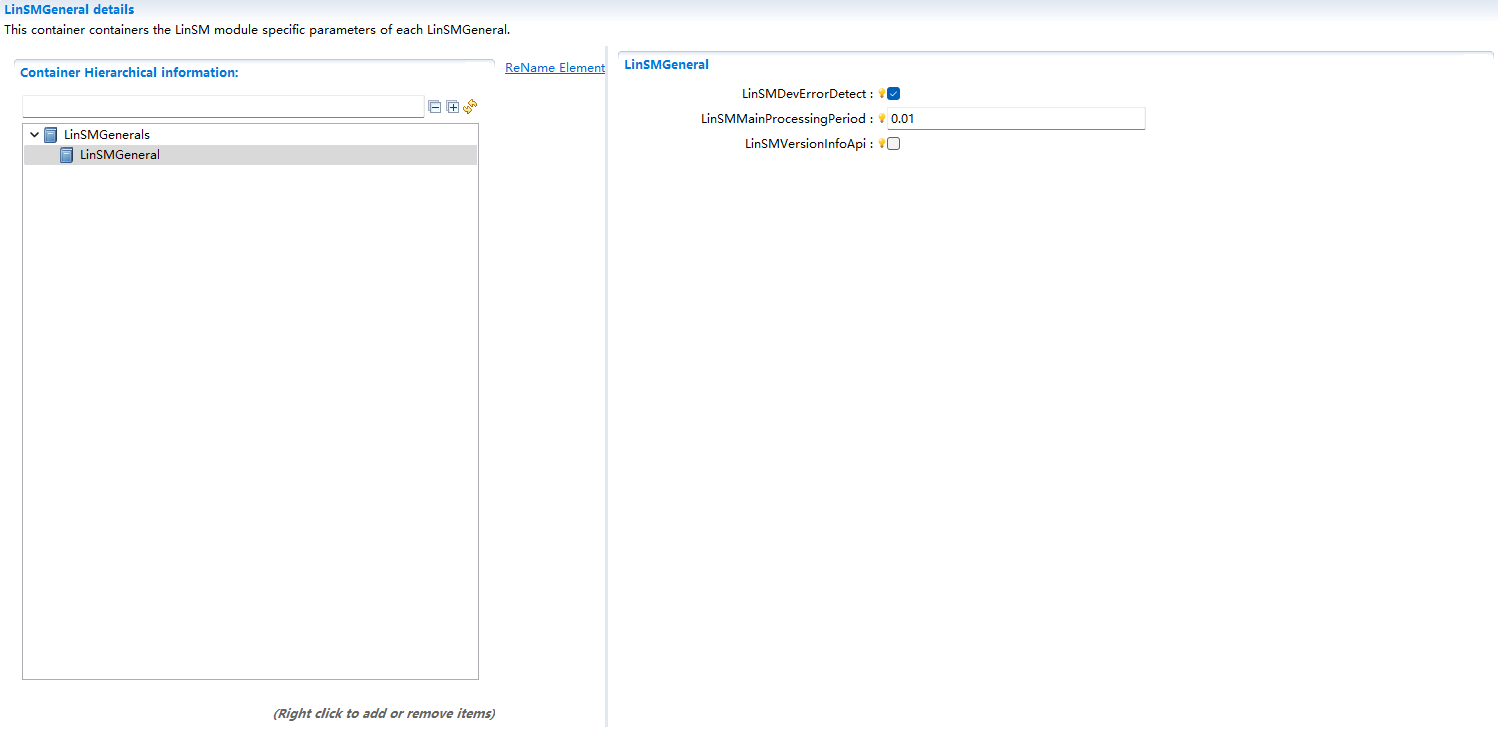
fig_LinSMMainProcessingPeriod¶
唤醒失败重试次数由全局性配置LinSMConfigSet/LinSMModeRequestRepetitionMax决定
The number of wakeup failure retries is determined by the global configuration LinSMConfigSet/LinSMModeRequestRepetitionMax.
1.LinSMModeRequestRepetitionMax配置截图:
1.Screenshot of LinSMModeRequestRepetitionMax configuration:
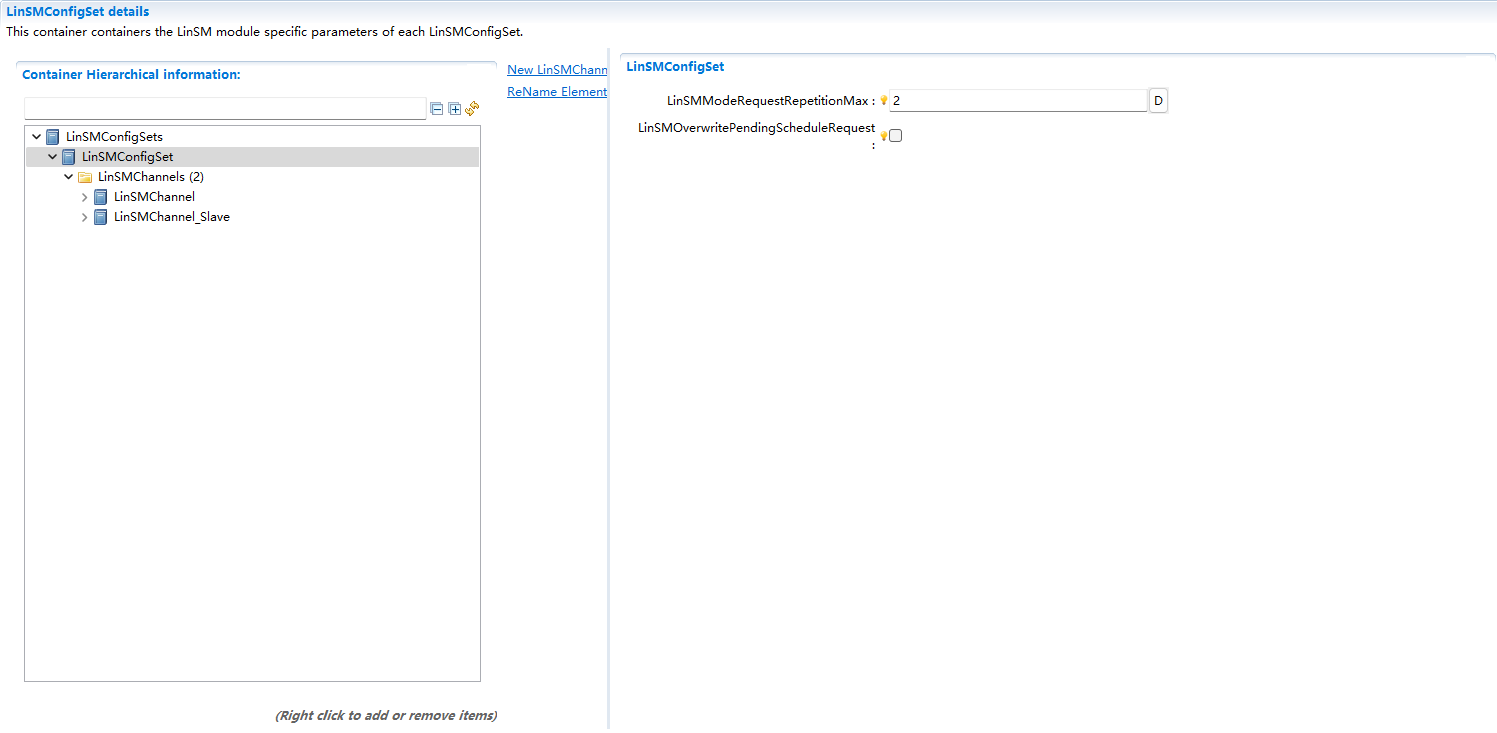
fig_LinSMModeRequestRepetitionMax¶
调度表配置 Schedule Table Configuration¶
调度表配置位于各通道的配置下子容器:LinSMChannel/LinSMSchedule,调度表配置以及相应函数功能仅支持MASTER节点,使用调度表配置需要先将通道类型LinSMChannel/LinSMNodeType配置为MASTER
The schedule table configuration is located in the sub-container under the configuration of each channel: LinSMChannel/LinSMSchedule. The schedule table configuration and corresponding function features only support MASTER nodes. To use the schedule table configuration, the channel type (LinSMChannel/LinSMNodeType) must first be configured as MASTER.
1.LinSMNodeType配置截图:(下拉框选择配置参数)
1.Screenshot of LinSMNodeType configuration: (Select configuration parameters from the drop-down box)
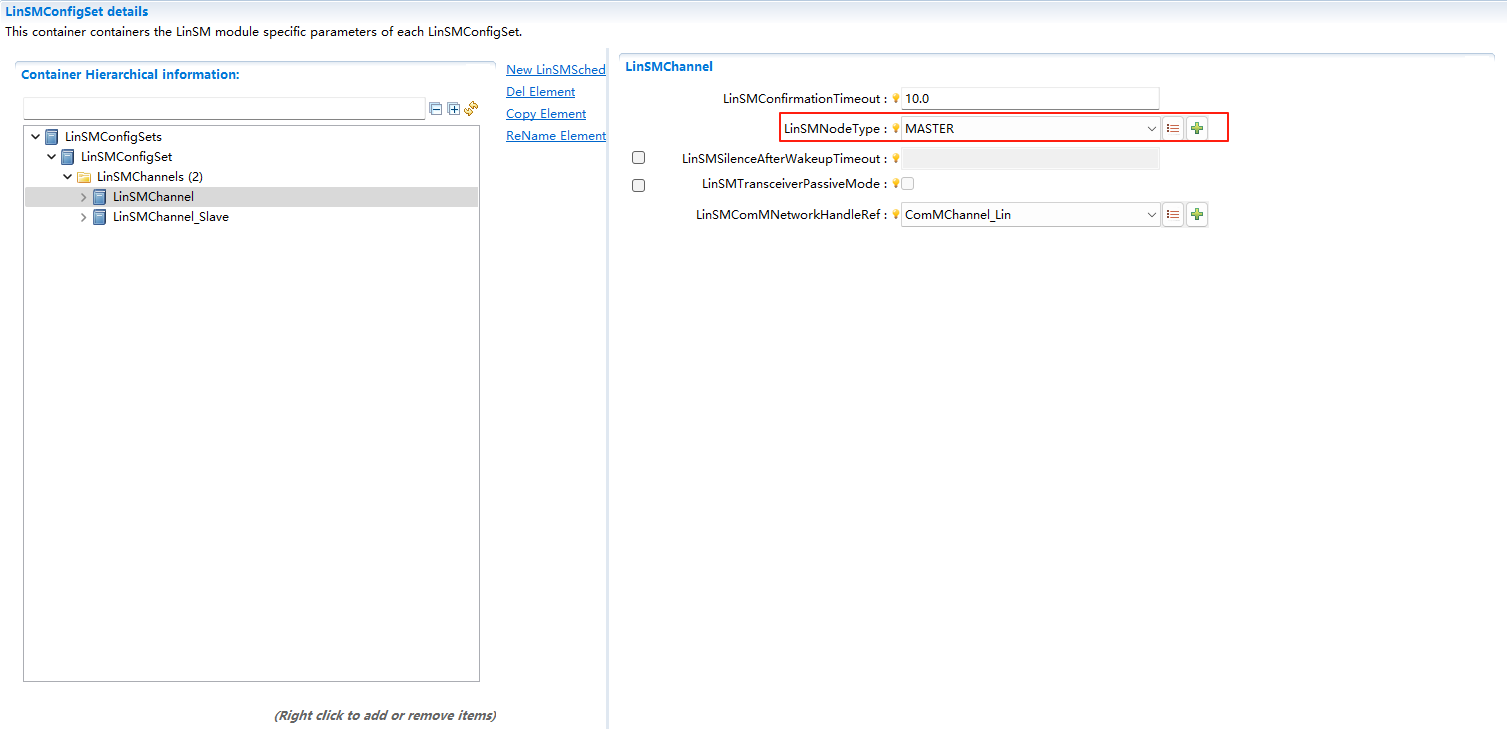
fig_LinSMNodeType¶
LinSMChannel/LinSMSchedule容器中,LinSMScheduleIndex依次递增自动配置,供以BswM请求调度表切换使用,范围[0 ..255]; LinSMScheduleIndexRef引用LinIf模块LinIfScheduleTable配置。
In the LinSMChannel/LinSMSchedule container, LinSMScheduleIndex is automatically configured in increasing order and is used for BswM to request schedule table switching, with a range of [0 .. 255]; LinSMScheduleIndexRef references the LinIf module’s LinIfScheduleTable configuration.
1.LinSMSchedule配置截图
1.Screenshot of LinSMSchedule configuration
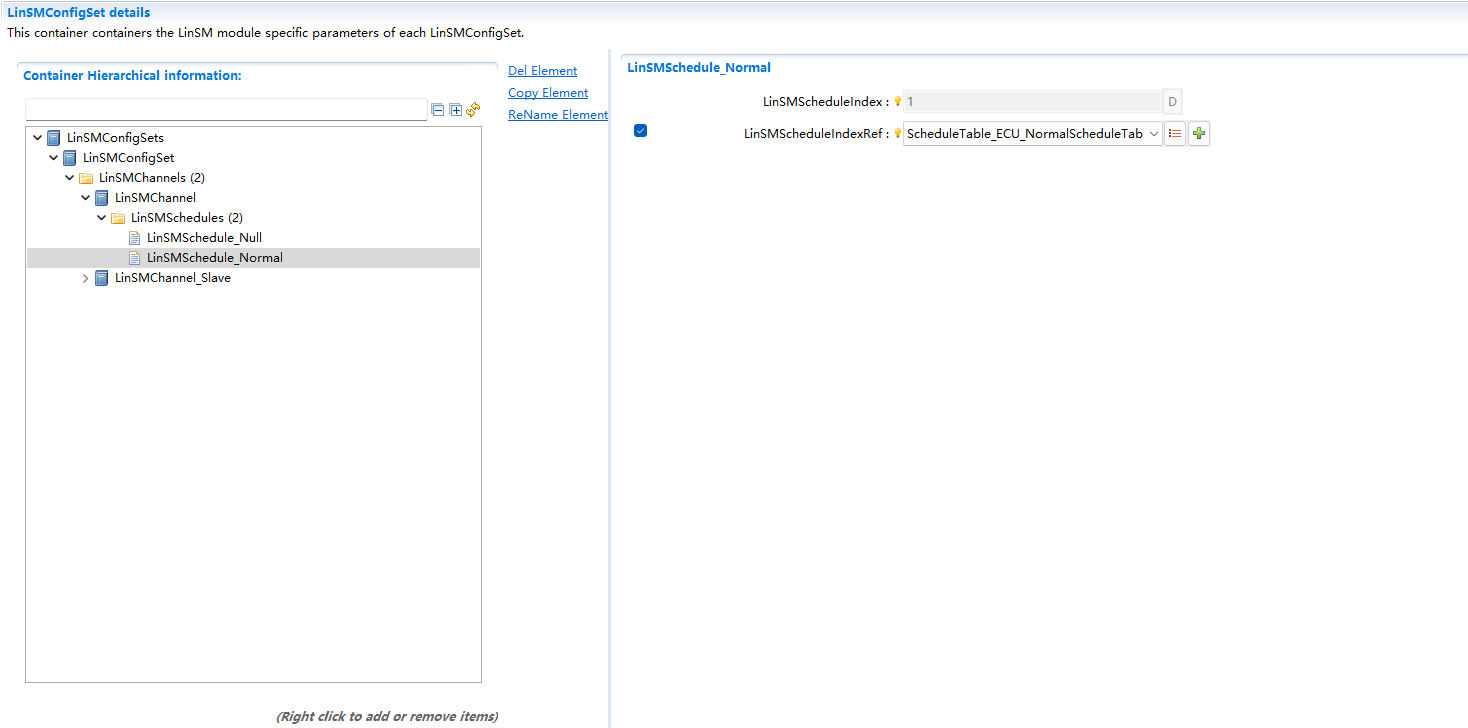
fig_LinSMSchedule¶
1.LinSMScheduleIndexRef引用的来源:LinIfScheduleTable
1.Source referenced by LinSMScheduleIndexRef: LinIfScheduleTable
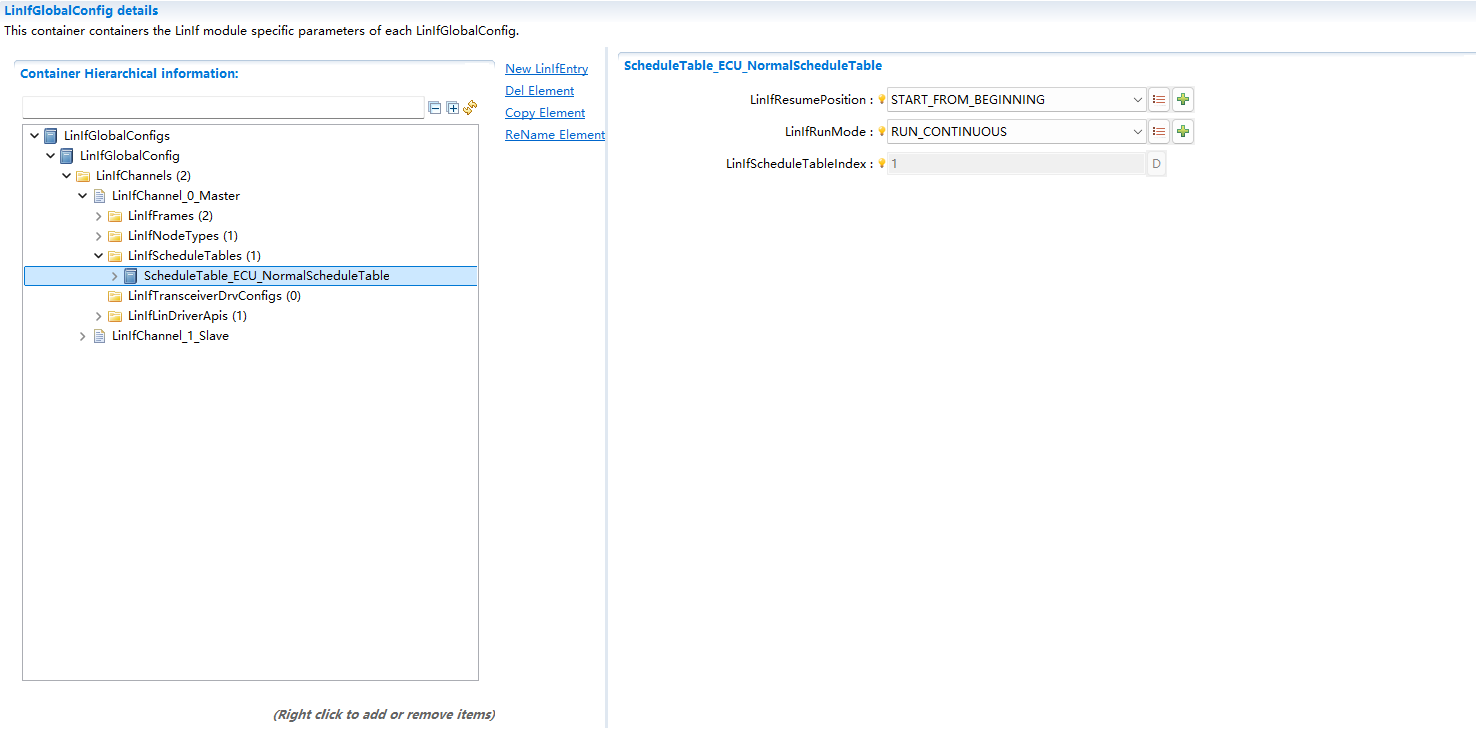
fig_LinIfScheduleTable¶